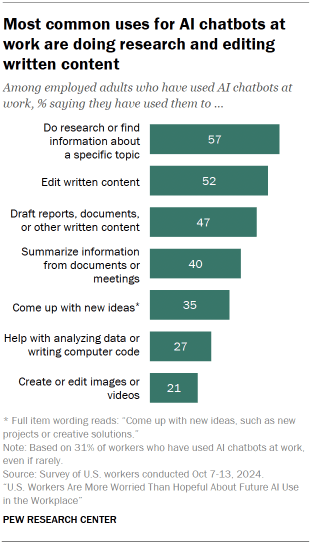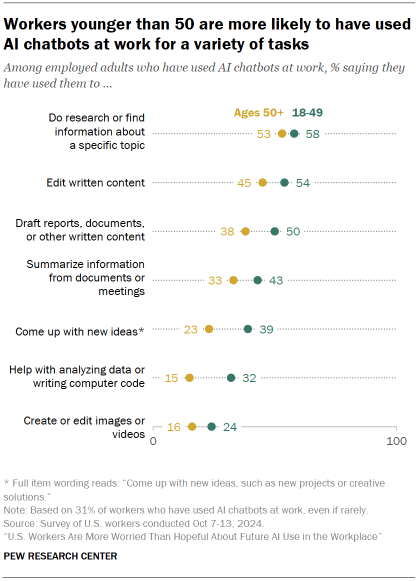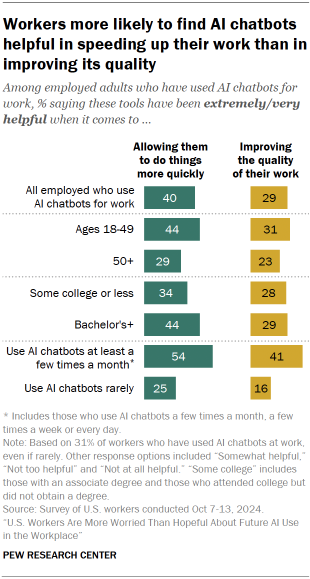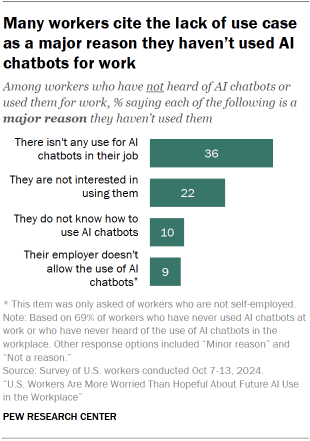In addition to asking workers how they feel about and use AI in the workplace generally, we asked a series of questions specifically about workplace use of AI chatbots – such as ChatGPT, Gemini or Copilot.
A majority of workers (55%) rarely or never use AI chatbots at work. An additional 29% haven’t heard of this at all.
Relatively small shares of workers say they have used AI chatbots for work: 9% say they use them every day or a few times a week, and 7% say they use them a few times a month.
The groups who are more likely to have heard of AI chatbots are also more likely to use these tools:
- Workers ages 18 to 29 (23% say they use them at least a few times a month)
- Workers with a postgraduate degree (26%)
How workers are using AI chatbots in their jobs

The most common uses for AI chatbots among workers who’ve used them at work include:
- Doing research or finding information about a specific topic (57% of workers who have used AI chatbots at work say they’ve done this)
- Editing written content (52%)
- Drafting reports, documents, or other written content (47%)
Four-in-ten or fewer say they’ve used AI chatbots at work to:
- Summarize information from documents or meetings (40%)
- Come up with new ideas, such as new projects or creative solutions (35%)
- Help with analyzing data or writing computer code (27%)
- Create or edit images or videos (21%)

Workers ages 18 to 49 are more likely than those ages 50 and older to say they have used AI chatbots for almost all the work tasks we asked about.
For example, among workers who have used AI chatbots at work, half of those ages 18 to 49 say they have used them to draft reports, documents or other written content, while only 38% of those ages 50 and older say they have done this.
Similarly, 39% of workers 18 to 49 who have used AI chatbots say they have used them to come up with new ideas. This compares with 23% of those ages 50 and older.
The only exception is on doing research or finding information about a specific topic. The shares of younger and older workers who say they have used AI chatbots to do this are not statistically different (58% and 53%).
Among workers who have used AI chatbots for work, those with at least a bachelor’s degree are more likely than those with some college or less education to say they have used AI chatbots for some of the work tasks we asked about. There are significant differences by education when it comes to doing research or finding information about a specific topic; editing written content; drafting reports, documents or other written content; and coming up with new ideas.
Do workers find AI chatbots helpful for their work?

Among workers who have used AI chatbots for work, 40% say these tools have been extremely or very helpful in allowing them to do things more quickly. A smaller share (29%) say they have been highly helpful in improving the quality of their work.
Views on this differ by age, education and how frequently workers use AI chatbots.
Workers ages 18 to 49 are more likely than those ages 50 and older to find AI chatbots highly helpful in allowing them to do things more quickly (44% vs. 29%) and in improving the quality of their work (31% vs. 23%).
Workers with at least a bachelor’s degree are also more likely than those with some college or less education to find AI chatbots highly helpful in allowing them to do things more quickly (44% vs. 34%).
However, in terms of improving work quality, about the same shares of workers across education levels say AI chatbots have been highly helpful: 28% among those with some college or less education and 29% among those with at least a bachelor’s degree.
Workers who use AI chatbots at least a few times a month are much more likely than workers who rarely use them to find these tools helpful. Among workers who use AI chatbots regularly, 54% say they’ve been highly helpful in speeding up their work and 41% say they’ve been highly helpful in improving their work quality. Smaller shares among workers who rarely use AI chatbots say the same (25% and 16%, respectively).
Why some workers have not used AI chatbots for work
Most workers (69%) do not use AI chatbots at work. This includes 40% who have never used them for work and 29% who have not heard about AI chatbot use in the workplace.

Among workers who are not AI chatbot users, 36% say a major reason they have never used AI chatbots for work is that there isn’t any use for them in their job.
About one-in-five (22%) say a major reason they haven’t used AI chatbots is because they’re not interested in using them. Smaller shares say they do not know how to use AI chatbots (10%) or their employer does not allow the use of AI chatbots (9%).
Within this group of non-users, workers ages 50 and older are more likely than those ages 18 to 49 to say they haven’t used AI chatbots for work because they don’t know how to use them (13% vs. 8%). There aren’t significant differences by age for the rest of the items.
Do employers encourage use of AI chatbots for work?

Among all workers who are not self-employed, half say their employer neither encourages nor discourages the use of AI chatbots at work. Some 12% say their employer encourages it, and 8% say their employer discourages it.
The shares of workers who say their employer encourages the use of AI chatbots for work are small across most industries, but the following stand out for sizable shares of workers saying their employer encourages it:
- Information and technology (36% say this)
- Banking, finance, accounting, real estate or insurance (24%)
- Professional, scientific and technical services (19%)


